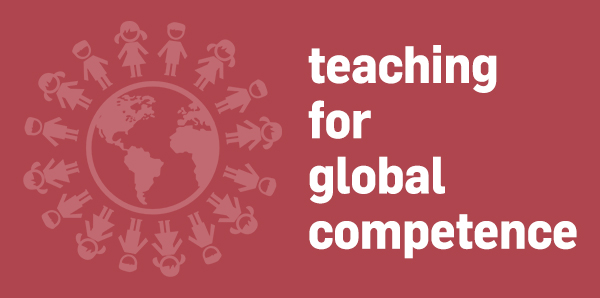The globalization of economies, mass migration, the digital revolution, and other universal advancements have changed the skills required to succeed in today’s world. Students’ learning needs to be more powerful and relevant than ever before. It must respond to these new demands and opportunities.
Global competence refers to the acquisition of in-depth knowledge and understanding of international issues, an appreciation of an ability to learn and work with people from diverse linguistic and cultural backgrounds, proficiency in a foreign language, and skills to function productively in an interdependent world community1.
Framework for Global Competence
There are four key elements or steps, to the global competence framework. What is most important when teaching each one of these elements, is to understand that questions play a big role in each step. Getting learners to become globally competent, means getting them to constantly ask questions.
First Step: Investigate The World
The first step in the direction of global competence is investigating the world, getting students to be curious about what is outside their immediate environment. These are the four ways in which students can investigate the world2:
- Identifying an issue, producing a question, and explaining its significance locally, regionally, and globally.
- Using a variety of languages and domestic and international sources to identify and address a globally significant question.
- Analyzing, integrating, and synthesizing information to arrive at a coherent response to significant questions.
- Developing an argument based on facts that consider different perspectives and results in legitimate conclusions.
Second Step: Recognize Perspectives
When learners manage to investigate the world, is important for them to recognize perspectives. This is the second step toward becoming globally competent.
Part of the process of recognizing perspectives is identifying their own. Learning that their environment and experiences influence their point of view. Understanding how others view and comprehend the world, allows them to identify different perspectives other than their own. With that, enabling them to examine the way that cultural interactions impact past, current, and future situations. And being capable to articulate how different access to knowledge and information affects these perspectives.

Third Step: Communicate Ideas
The third step is communicating ideas. Students must be able to thoughtfully differentiate among audiences and adapt their behavior accordingly, working together in diverse teams to achieve a common goal.
Learners must apply their knowledge on perspectives, to understand how information can be perceived differently and how to adapt their message. They need to listen and use correct verbal and nonverbal practices, taking into account languages and strategies. They also need to use the correct technology and media to get their ideas across.
Fourth Step: Take Action
A globally competent student is the one that not only possesses multicultural knowledge but also uses it to make a difference in the world. The last step of the framework is taking action. Learners should be able to identify opportunities for change and improvement, ways to collaborate locally, regionally, and internationally. And reflect on their power to advocate for advancement.
Languages in a Globally Competent Curriculum
The study of world languages is a core component of global competence. Virtually all of the highest performing nations in the world require their students to begin sustained second language instruction from an early age.
Globally competent schools adapt their curriculum, instruction, and assessment to systematically infuse multicultural education to their students’ learning experience. Making world languages an especially important component.
Acquiring a second language gives learners the possibility to make comparisons within the target language culture and their own and to grasp a deeper understanding of differing perspectives. It gives the students the skill to adapt their messages to their audiences and to communicate their ideas effectively in a local, regional, and international context.
Students should communicate with various audiences including native speakers of the language and using their developing skills in authentic contexts. The best world language programs are those that go beyond language proficiency to build a more comprehensive framework for the development of students’ global competence3.
Internationalizing the Classroom with Language Assistants
Allowing students to interact directly with a native speaker of another language, benefits them from learning firsthand about other cultures, perspectives, and ways of communicating ideas.
It prepares them for future experiences abroad and strengthens their ability to become more globally competent.

Meddeas Language Assistants bring the Spanish culture and, with it, the European culture into the classroom. Sharing different teaching styles, techniques, and initiatives that globalize the students’ learning experience and the teachers’ curriculum.
Hiring a Spanish Language Assistant at your school will give your students and staff the possibility to host qualified Spanish teachers to support the school’s Spanish Department with conversation practice. These Spanish teachers will help other teachers, as an aid, in the classroom or extra-curricular activities4.
This will be a unique opportunity to:
- Host qualified Spanish teachers who will globalize the classroom.
- Learn from a native Spanish speaker.
- Enrich the multicultural environment of the school.
- Promote intercultural exchanges.
1 Global competence is a 21st Century Imperative – A NEA policy brief
2 Educating for Global Competence: Learning Redefined for an Interconnected World
3 Educating for Global Competence: Preparing Our Youth to Engage the World
4 Meddeas Language Assistants: Improve your Foreign Language Teaching

